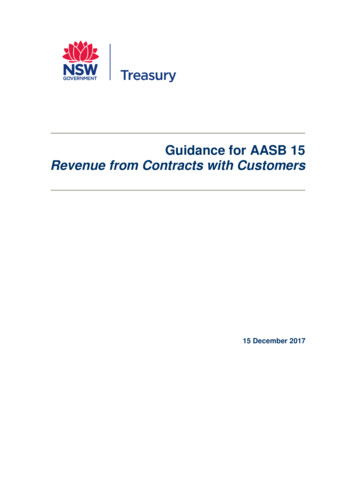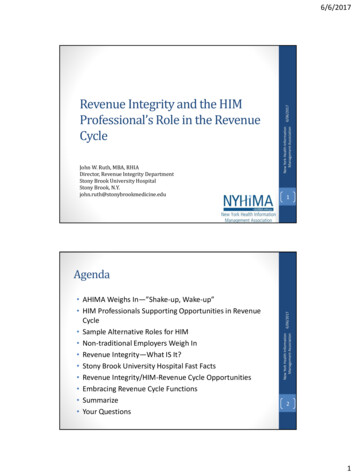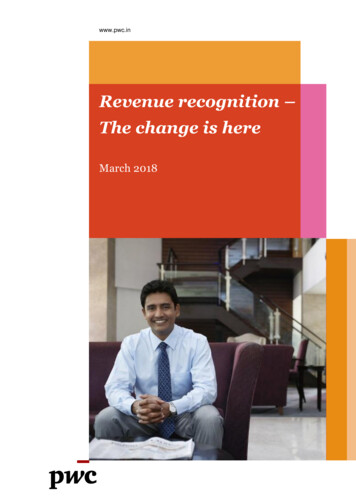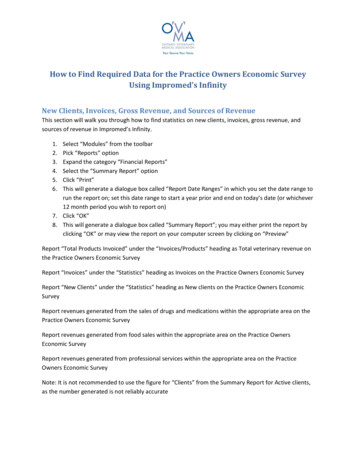
Transcription
Guidance for AASB 15Revenue from Contracts with Customers15 December 2017
ContentsOverview . 41.1Objective . 41.2Main impact . 41.3Scope . 5Key Considerations . 62.1Comprehensive revenue recognition model . 62.2Interaction with other standards . 62.3Portfolio approach . 72.4Contract costs . 83.3.13.23.33.43.5Five step revenue recognition model . 9Step 1 - Identify the contract with the customer . 93.1.1Contract criteria . 103.1.2Enforceability . 103.1.3Contract term . 103.1.4Collectability. 113.1.5Combined contracts . 113.1.6Additional Step 1 considerations for NFP entities . 11Step 2 - Identify the performance obligations in the contract . 133.2.1Promises in a contract . 143.2.2Determining when promises are performance obligations . 143.2.3Determining whether goods or services are ‘distinct’. 153.2.4Series of distinct goods or services . 163.2.5Additional Step 2 considerations for NFP entities . 17Step 3 - Determine the transaction price . 183.3.1Variable consideration and constraining estimates of variable consideration . 193.3.2Significant financing component. 233.3.3Non-cash consideration . 243.3.4Consideration payable to a customer . 25Step 4 – Allocate the transaction price to each performance obligation . 263.4.1Allocation based on stand-alone selling prices . 273.4.2Allocation of a discount . 283.4.3Allocation of variable consideration . 293.4.4Additional Step 4 considerations for NFP entities . 29Step 5 - Recognise revenue when (or as) performance obligations are satisfied. 303.5.1Control-based revenue recognition approach. 313.5.2Performance obligations satisfied over time . 323.5.3Performance obligations satisfied at a point in time. 34Guidance for AASB 15 Revenue from contracts with customers2
4.Other AASB 15 topics . 354.1Contract modifications. 354.2Principal versus agent . 404.3Licences of intellectual property . 414.4Customer options for additional goods or services . 425.5.1Transitional Requirements and Relief . 45Transition options. 455.1.1Full retrospective approach . 465.1.2Modified retrospective approach . 47Disclosures. 496.1Disaggregation of revenue . 506.2Contract balances . 506.3Performance obligations . 516.4Significant judgements . 516.5Costs to obtain or fulfil a contract . 526.6Transition disclosures . 52Guidance for AASB 15 Revenue from contracts with customers3
Overview1.1ObjectiveAASB 15 Revenue from Contracts with Customers (AASB 15) is effective for NSW for-profitpublic sector agencies from FY2018/19 and a year later (i.e. FY 2019/20) for the not-forprofit (NFP) agencies. The key objectives are: A more robust framework to address revenue recognition issues Streamline and reduce the volume of the relevant standards and interpretations More useful information to users through expanded disclosuresAASB 2016-3 Amendments to Australian Accounting Standards – Clarifications to AASB 15(AASB 2016-3) was subsequently published to clarify some concepts to AASB 15 andprovide further practical expedients on transition to AASB 15.AASB 2016-8 Amendments to Australian Accounting Standards – Australian ImplementationGuidance for Not-for-Profit Entities (AASB 2016-8) was published to include an appendix toAASB 15 on implementation guidance for NFP entities. This implementation guidance for theNFP entities has been incorporated in this document in grey shaded text.This Treasury guidance provides an overview of the requirements of AASB 15 includingdisclosures and practical transitional impacts. However, agencies still need to reviewAASB 15 in detail to ensure they understand its requirements.Agencies should review the illustrative examples in IFRS 15 Revenue from Contracts withCustomers (IFRS 15) to understand the application of AASB 15 to particular aspects of acontract with a customer. The illustrative examples are not part of AASB 15 but availablein AASB’s website- RS15 IE 5-14.pdfIFRS references are used in this guidance to draw attention to the ‘basis of conclusions’ onIFRS 15. Also refer to the clarification issued in April 2016 on some of the ‘basis ofconclusions’ on IFRS 15.1.2Main impactCurrently, revenue transactions are often separated into components that are accounted forunder different revenue standards and interpretations. This is no longer the case as AASB15 provides a single framework for revenue recognition using a five-step model.AASB 15 replaces the following: AASB 111 Construction Contracts (AASB 111) AASB 118 Revenue (AASB 118) Interpretation 13 Customer Loyalty Programmes Interpretation 15 Agreements for the Construction of Real Estate Interpretation 18 Transfers of Assets from Customers Interpretation 131 Revenue – Barter Transactions Involving Advertising Services Interpretation 1042 Subscriber Acquisition Costs in the Telecommunications Industry.Guidance for AASB 15 Revenue from contracts with customers4
Key changes AASB 15 is principles-based and provides substantial application guidance. AASB 15extensively discusses various revenue recognition topics with examples.Revenue recognition is now based on when control of the goods or services transferto the customer. Under AASB 118, recognition was based on when risks andrewards transferred. Risks and rewards are retained as an indicator of the transfer ofcontrol, but not the only indicator.There is more specific guidance on identifying performance obligations in a contract,compared to existing pronouncements.Revenue recognition may be accelerated or deferred, compared to existingpronouncements. In particular for revenue contracts with multiple components,variable consideration, and licences.Interest and dividend income are excluded from the scope of AASB 15 and moved toAASB 9 Financial Instruments.There are significant additional disclosure requirements to provide more usefulinformation to financial statement users.AASB 15 primarily aims to be a single comprehensive revenue recognition framework, with aclearly explained revenue recognition approach and elaborate guidance on various revenuestreams.While these changes are significant, entities having revenue transactions with complexfeatures like multiple deliverables (i.e. bundled goods and services), variable selling prices(including rebates, discounts, etc.), non-standard contract clauses etc. are most likely to beimpacted.Therefore, there may be a limited impact for many NSW public sector entities, especiallyNFP entities. However this can only be determined through a review of revenue contracts.1.3ScopeAn entity should apply AASB 15 to all contracts with customers, except (AASB 15.5): lease contracts; insurance contracts; non-monetary exchanges between entities in the same line of business to facilitatesales to customers or potential customers; and financial instruments and other contractual rights or obligations within the scope ofAASB 9 Financial Instruments, AASB 10 Consolidated Financial Statements, AASB11 Joint Arrangements, AASB 127 Separate Financial Statements and AASB 128Investments in Associates and Joint Ventures.Guidance for AASB 15 Revenue from contracts with customers5
Key Considerations2.1Comprehensive revenue recognition modelAASB 15 describes the principles to be applied in measuring and recognising revenue andthe related cash flows from contracts with customers. The core principle is that an entity willrecognise revenue at an amount that reflects the consideration entitled in exchange fortransferring goods or services to a customer.AASB 15 provides a new comprehensive framework for revenue recognition andmeasurement using the following five-step model:Five step revenue recognition modelStep 1Identify thecontract withthe customer2.2Step 2Identify theperformanceobligations inthe contractStep 3Determine thetransactionpriceStep 4Allocate thetransactionprice to eachperformanceobligationStep 5Recogniserevenue when(or as)performanceobligationsare satisfiedInteraction with other standardsA contract with a customer may partially be in scope of AASB 15 and partially within thescope of other Standards, e.g. a contract for the lease of an asset and maintenance of theleased equipment.In such instances, an entity must first apply the other standards if those standards specifyhow to separate and/or initially measure one or more parts of the contract. The entity willthen apply AASB 15 to the remaining components of the contract (AASB 15.7).For example - If a contract includes a financial instrument (e.g. financial guarantee) and arevenue component, the fair value of the financial instrument is first measured under AASB9 Financial Instruments and the balance contract consideration is allocated in accordancewith AASB 15.Transactions that fall within the scope of multiple standards should be separated intocomponents, so that each component can be accounted for under the relevant standards.This is demonstrated in the decision tree below.Guidance for AASB 15 Revenue from contracts with customers6
Decision tree for the application of AASB 15Contract fully in scope ofother accountingstandards?YesOther standardsapply(e.g. AASB 16)NoContract partially inscope of otheraccounting standards?NoApplyAASB 15YesDoes that other standardaddress separationand/or measurement?NoYesApply the otherstandard (e.g.AASB 16) for therelevant portionof the contractApplyAASB 15 for thebalance2.3Step 1Step 2Portfolio approachAASB 15 is generally applied to an individual contract with a customer. However, as apractical expedient, an entity may apply AASB 15 to a portfolio of contracts (or performanceobligations) with similar characteristics, if the impact of such portfolio application is notmaterially different compared to application by individual contracts (AASB 15.4).When accounting for a portfolio, an entity should use estimates and assumptions that reflectthe size and composition of the portfolio. The portfolio approach can be applied to bothcontract revenue and costs.Agencies should refer to illustrative example No.22 (IFRS 15.IE110-IE115) on portfolioapplication.Guidance for AASB 15 Revenue from contracts with customers7
2.4Contract costsAASB 15 provides guidance on accounting for the incremental costs of obtaining a contractwith a customer and costs to fulfil a contract.Incremental costs of obtaining a contractIncremental costs of obtaining a contract are costs that would not otherwise have beenincurred, and will include costs such as sales commissions, legal fees, travel costs,employee compensation solely tied to specific contracts etc.An entity should recognise incremental costs incurred to obtain a contract as assets (i.e.contract assets) if it expects to recover these costs (AASB 15.91). These assets are thenamortised on a basis consistent with the transfer of goods or services to the customer(AASB 15.99)There is a practical expedient if the amortisation period of the asset is one year or less. Inthis case the cost can be expensed immediately (AASB 15.94).Costs to obtain a contract that would have been incurred regardless of whether the contractwas obtained should be expensed when incurred, unless those costs are explicitlychargeable to the customer (AASB 15.93).Costs to fulfil a contractIf costs incurred in fulfilling a contract are in the scope of another Standard, that Standard isapplied (e.g. inventory, intangibles or property, plant and equipment). If another Standarddoes not apply, then a contract asset is recognised only if the fulfilment costs (AASB 15.95): relate directly to an existing contract or specific anticipated contract; generate or enhance resources of the entity that will be used to satisfy theperformance obligations in the future; and the costs are expected to be recoveredThese assets are then amortised on a basis consistent with the transfer of goods or servicesto the customer (AASB 15.99).If the costs do not meet the capitalisation criteria, then they should be expensed as incurred.Costs that may be recognised as asset(AASB 15.97)Costs expensed as incurred (AASB 15.98) direct labour (e.g. salary and wages) direct materials (e.g. supplies) allocated costs (e.g. depreciation,insurance, contract managementcosts) costs explicitly chargeable to thecustomer other direct costs incurred onlybecause of the contract (e.g.payments to subcontractors) general and administrative costs, unlessexplicitly chargeable to the customercosts of wasted materials, labour or otherresources not reflected in the contract pricecosts relating to satisfied performanceobligations (or partially satisfiedperformance obligations) in the contract, i.e.costs relating to past performancecosts that do not clearly relate to unsatisfiedor partially satisfied performance obligationsGuidance for AASB 15 Revenue from contracts with customers8
3.Five step revenue recognition modelAgencies should apply a five step model to determine the timing and quantum of revenue tobe recognised. The core principle (see Section 2.1 above) is to recognise revenue thatreflects the consideration entitled for transferring goods or services.The model: introduces key aspects like customer, enforceable contract, performance obligations,transaction price and price allocation; and prescribes the ground rules in evaluating the above aspectsto help achieve the core principle.Under the model revenue is recognised when (or as) an entity transfers control of goods orservices to a customer (AASB 15.31) at an amount which the entity is entitled to (AASB15.47). Specifically, revenue is recognised: 3.1over time, in a manner that depicts the entity’s performance obligations (AASB15.35-37); orat a point in time, when the control of the goods or services is transferred to thecustomer (AASB 15.38)Step 1 - Identify the contract with the customerThe first step in applying AASB 15 is to determine if a contract exists and whether thecontract meets all the criteria to be in the scope of AASB 15. This assessment is made on acontract-by-contract basis, although as a practical expedient an entity may apply thisguidance to a portfolio of similar contracts (see Section 3.1.5).Table 1 – Summary of key considerations for Step 1The following sections discuss and expand on the key criteria a contract must meet to be inthe scope of AASB 15. There are also sections on specific circumstances.Section TopicDescription of Section Contents3.1.1Contract criteriaThis section addresses the central requirements that: there is a contract with a customer; and the contract meets certain criteria to be in the scope ofAASB 153.1.2EnforceabilityThis section discusses what an enforceable contact is.3.1.3Contract termAASB 15 is applied to the duration of the contract.3.1.4CollectabilityThe assessment of a customer’s credit risk is important indetermining whether a contract is valid.3.1.5CombinedcontractsIn certain circumstances AASB 15 requires two or morecontracts to be treated as a single contract.3.1.6NFPconsiderationsThis section discusses the following contractconsiderations from a not-for-profit perspective: Identifying the customer Enforceability The concept of commercial substanceGuidance for AASB 15 Revenue from contracts with customers9
3.1.1Contract criteriaA contract is an agreement between two or more parties that creates enforceable rightsand obligations (AASB 15 Appendix A Defined Terms).An entity should account for a contract with a customer under AASB 15 if all of the followingcriteria are met (AASB 15.9):(a) the parties to the contract have approved the contract (in writing, orally or inaccordance with other customary business practices) and are committed to performtheir respective obligations(b) the entity can identify each party’s rights regarding the goods or services to betransferred(c) the entity can identify the payment terms for the goods or services to be transferred(d) the contract has commercial substance (i.e. the risk, timing or amount of the entity’sfuture cash flows is expected to change as a result of the contract)(e) it is probable that the entity will collect the consideration entitled in exchange for theunderlying goods or services.If a contract meets the above criteria at inception, an entity should not reassess thosecriteria unless there is an indication of a significant change in facts and circumstances e.g.deterioration in credit quality (AASB 15.13).If a contract does not meet the above criteria, the entity should recognise the considerationreceived as revenue only when (AASB 15.15): the entity has no remaining obligations, receives all or substantial considerationwhich is non-refundable; or the contract has been terminated and the consideration received is non-refundable.3.1.2EnforceabilityEnforceability of the rights and obligations in a contract is a matter of law. Contracts can bewritten, oral or implied by an entity’s customary business practices. The practices andprocesses for establishing contracts vary within and across entities, industries andjurisdictions (AASB 15.10).3.1.3Contract termAASB 15 is applied to the duration of the contract.Some contracts may have no fixed duration and can be terminated or modified by eitherparty at any time. Other contracts may automatically renew on a periodic basis specified inthe contract. The duration of the contract is the contractual period in which the parties to thecontract have present enforceable rights and obligations (AASB 15.11).A contract does not exist under AASB 15 if each party to the contract has unilateralenforceable right to terminate a wholly unperformed contract without compensating the otherparty. A contract is wholly unperformed if (AASB 15.12): the entity has not yet transferred any promised goods or services to the customerthe entity has not yet received, and is not yet entitled to receive, any consideration inexchange for promised goods or services.Guidance for AASB 15 Revenue from contracts with customers10
3.1.4CollectabilityThe assessment of a customer’s credit risk is an important part of determining whether acontract is valid (IFRS 15.BC42). In evaluating whether collectability of an amount ofconsideration is probable, an entity should consider only the customer’s ability and intentionto pay that amount of consideration when it is due [AASB 15.9(e)].Example – collectabilityAn entity licences an intellectual property to a customer in exchange for a usage-basedroyalty. At contract inception, the contract meets all the criteria under AASB 15.9 andrevenue is recognised based on usage.During the second year of the contract, the customer continues to use the entity’s licence,but the customer’s financial condition declines and their ability to pay significantlydeteriorates.Analysis and accounting treatment:The entity recognises royalty earned in the first year as revenue, as the contract meets therecognition criteria under AASB 15. In the second year, the entity determines it is no longerprobable to collect the entitled consideration. Therefore, the entity does not recognise anyfurther revenue associated with the customer’s future usage of its patent. The entityaccounts for any impairment of the existing receivable under AASB 9 Financial Instruments.3.1.5Combined contractsAn entity should combine two or more contracts entered into at or near the same time withthe same customer (or related parties of the customer) and account for the contracts as asingle contract, if one or more of the following criteria are met (AASB 15.17): the contracts are negotiated as a package with a single commercial objective the consideration to be paid in one contract depends on the price or performance ofthe other contract; or the goods or services promised are a single performance obligation (see Section3.2.2)3.1.6Additional Step 1 considerations for NFP entitiesCustomer of a NFP entityThe customer of a NFP entity is sometimes not clearly identifiable. The customer is theparty that promises consideration in exchange for goods or services that are an output ofthe entity’s ordinary activities. The customer might direct goods or services to be providedto third-party beneficiaries (including individuals or the community at large). In thesecontracts: the customer remains the party that has contracted with the entity and promisesconsideration in exchange for those goods or services the provision of goods or services to third-party beneficiaries is a characteristic ofthe promised transfer of goods or services to the customer (AASB 2016-8.F6).Example:A NFP entity receives consideration from an individual X for the specified purpose ofproviding first-aid training to members of the community.In this instance, the individual X is the customer because he/she has contracted with theentity to provide the first-aid training services. This conclusion is not affected by the factthat individual X specifies those services are to be provided to members of the community.Guidance for AASB 15 Revenue from contracts with customers11
Enforceable agreement for a NFP entityAn inherent feature of a contract with a customer is that the entity makes promises in anagreement that creates enforceable rights and obligations. NFP agencies should note thefollowing key considerations on enforceability: An agreement, whether in writing or oral, is enforceable when a separate party isable to enforce it through legal or ‘equivalent means’ (AASB 2016-8.F11).For an agreement to be enforceable through ‘equivalent means’, it requires thepresence of a mechanism outside the legal system that establishes the right of acustomer to oblige the entity to act in a particular way or be subject toconsequence. For example, a ministerial authority to require a transfer of goods orservices. Enforceability needs to be considered in relation to particular terms of anagreement and any additionally agreed terms as a result of further discussions oractions. Examples of terms in agreements that result in enforceability (AASB 20168.F12):o a refund in cash or kind when the agreed specific performance has notoccurred;o the customer, or another party acting on its behalf, has a right to enforcespecific performance or claim damages;o the customer has the right to a financial interest in assets purchased orconstructed by the entity;o the parties to the agreement are required to agree on alternative uses ofthe resources provided under the agreement; ando an administrative process exists to enforce agreements between sovereignStates or between a State and another party The enforceability of agreements does not depend on their form. For example,documents such as Memoranda of Understanding, Heads of Agreement andLetters of Intent can constitute legally enforceable agreements (AASB 20168.F13). Agreements that explicitly state they are not intended to be legally binding maynonetheless become enforceable agreements if the parties act in a manner that isinconsistent with the stated intention (AASB 2016-8.F13). Agreements that lack elements of a contract may nonetheless become legallyenforceable if there is conduct by one party that causes the other party to act inreliance on such conduct (AASB 2016-8.F13).Enforcement mechanisms may arise from administrative arrangements or statutoryprovisions e.g. a directive given by a Minister or government department to apublic sector entity (AASB 2016-8.F14). A capacity to impose a severe penalty for non-performance can exist without acapacity to require a return of transferred assets or assets of equivalent value. Theauthority to require compensation may be the key determinant of the enforceabilityof an agreement involving a promise to transfer goods or services (AASB 20168.F15). A contract could still be enforceable despite a lack of history of enforcement anddespite the customer’s intention not to enforce. The customer’s intent not toenforce is at its discretion and does not affect their right to enforce. Enforceabilitydepends on the customer’s capacity to enforce (AASB 2016-8.F16).Guidance for AASB 15 Revenue from contracts with customers12
A Statement of Intent is generally a public policy statement and does not identifythe parties who could enforce the statement. Such a statement of intent, of itself,would be insufficient to create an enforceable agreement. This is in contrast to aLetter of Intent which is typically an agreement between specifically identifiedparties (AASB 2016-8.F17). A transferor’s capacity to withhold future funding to which the entity is not presentlyentitled, would not, by itself, create an enforceable agreement (AASB 2016-8.F17).Commercial substanceA contract may have commercial substance even if it is non-commercial to the NFPentity (for example, subsidised goods or services). ‘Commercial substance’ should beread as a reference to economic substance i.e. giving rise to substantive rights andobligations (AASB 2016-8.F19).3.2Step 2 - Identify the performance obligations in the contractThis step requires an entity to determine whether the contract with a customer containsperformance obligations. These are promises to transfer distinct goods or services (AASB15.22). AASB 15 provides guidance on the meaning of ‘distinct’.Table 2 - Summary of key considerations for Step 2Section TopicDescription of Section Contents3.2.1Promises in a contractPromises can be explicit or implied.Administrative tasks to set up a contract are notperformance obligations.3.2.2Determining when promisesare performance obligationsPromises represent performance obligations if:- goods or services are distinct; or- goods and services are part of a seriesof similar distinct goods3.2.3Determining whether goodsor services are distinctA good or service is distinct if:- the customer can benefit from the goodor service on its own, or together withother readily available resources; and- the promise to transfer the good orservice is separately identifiable in thecontract3.2.4Series of distinct goods orservicesA series of distinct goods or services isconsidered a single performance obligation ifcertain criteria are met.Then, an entity applies revenue recognitionprinciples to a single performance obligation.3.2.5NFP considerationsThe promise of the NFP entity shoul
AASB 15 in detail to ensure they understand its requirements. Agencies should review the illustrative examples in IFRS 15 Revenue from Contracts with Customers (IFRS 15) to understand the application of AASB 15 to particular aspects of a contract with a customer. The illustrative exampl










